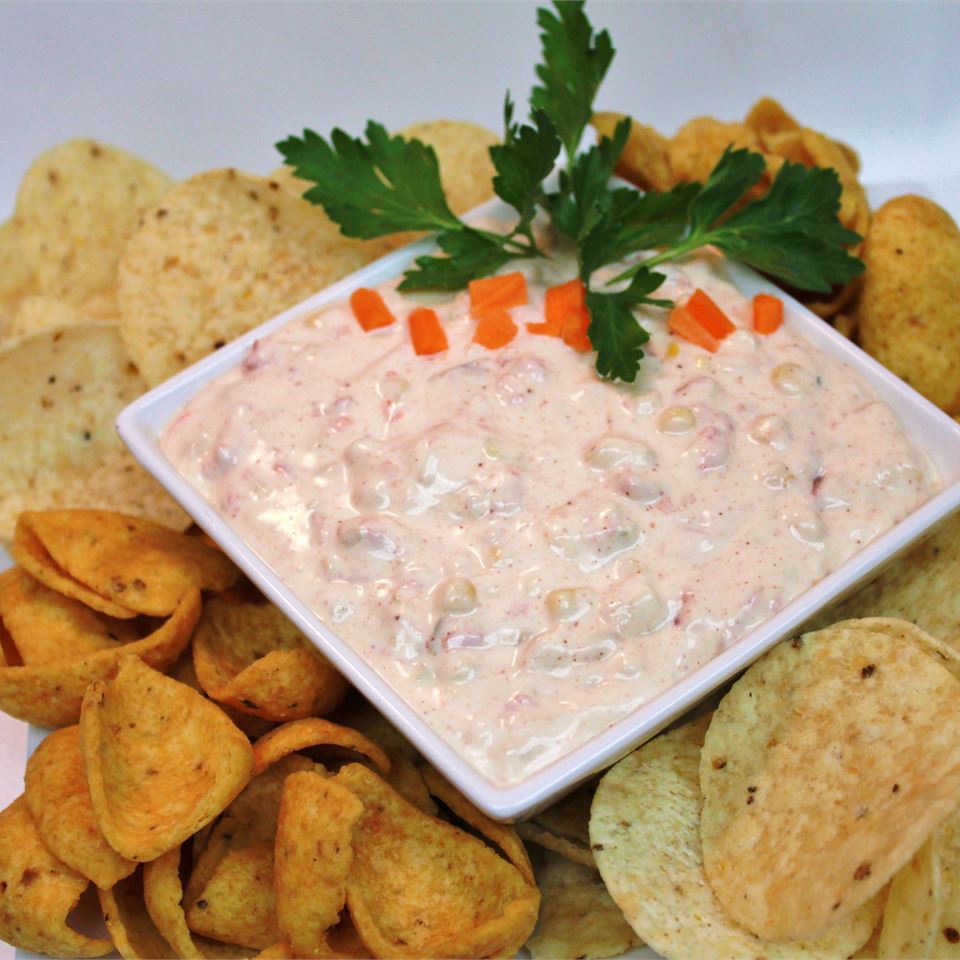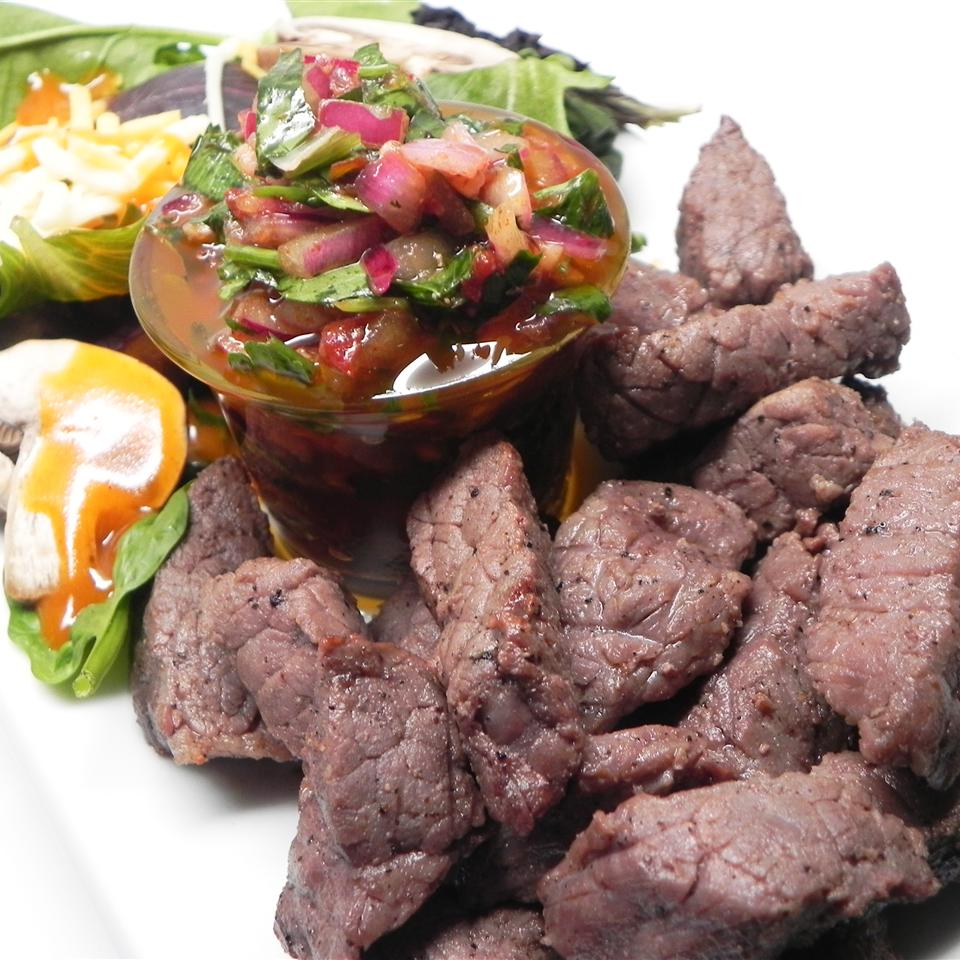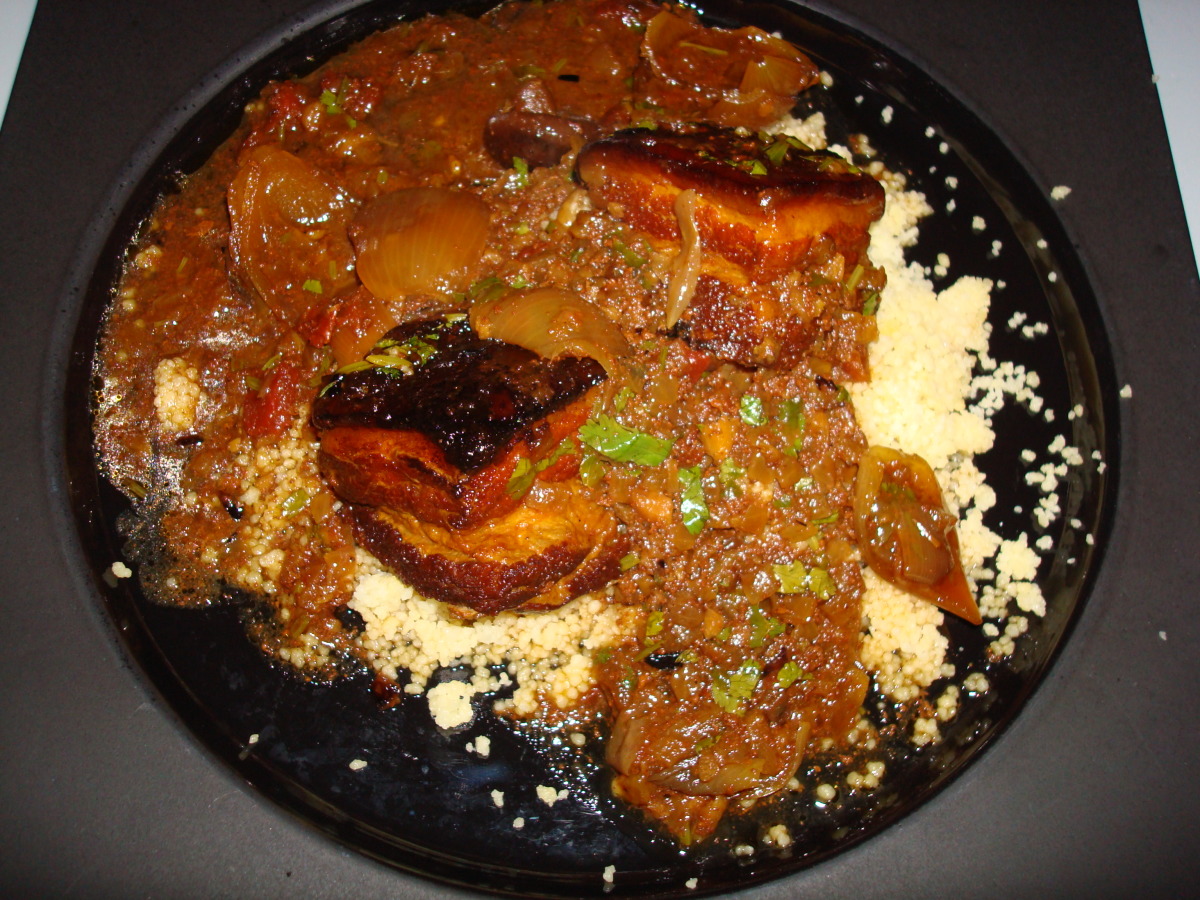Indulge in the delectable flavors of Injera, a traditional Ethiopian flatbread with a spongy texture and a slightly sour tang. Originating from the highlands of Ethiopia and Eritrea, Injera holds a central place in the culinary heritage of these regions. Typically made from teff flour, Injera's unique taste and texture come from the fermentation process, which imparts a complex sour flavor profile. It serves as the perfect accompaniment to stews, curries, and various other dishes with its porous surface acting as a perfect utensil to scoop up every morsel of flavorful goodness. Explore the diverse Injera recipes in this article, ranging from the classic teff Injera to variations using different flours like wheat, barley, and sorghum. Discover the secrets of preparing this versatile flatbread and elevate your culinary skills with this essential Ethiopian staple.
Let's cook with our recipes!
INJERA (ETHIOPIAN TEFF BREAD)
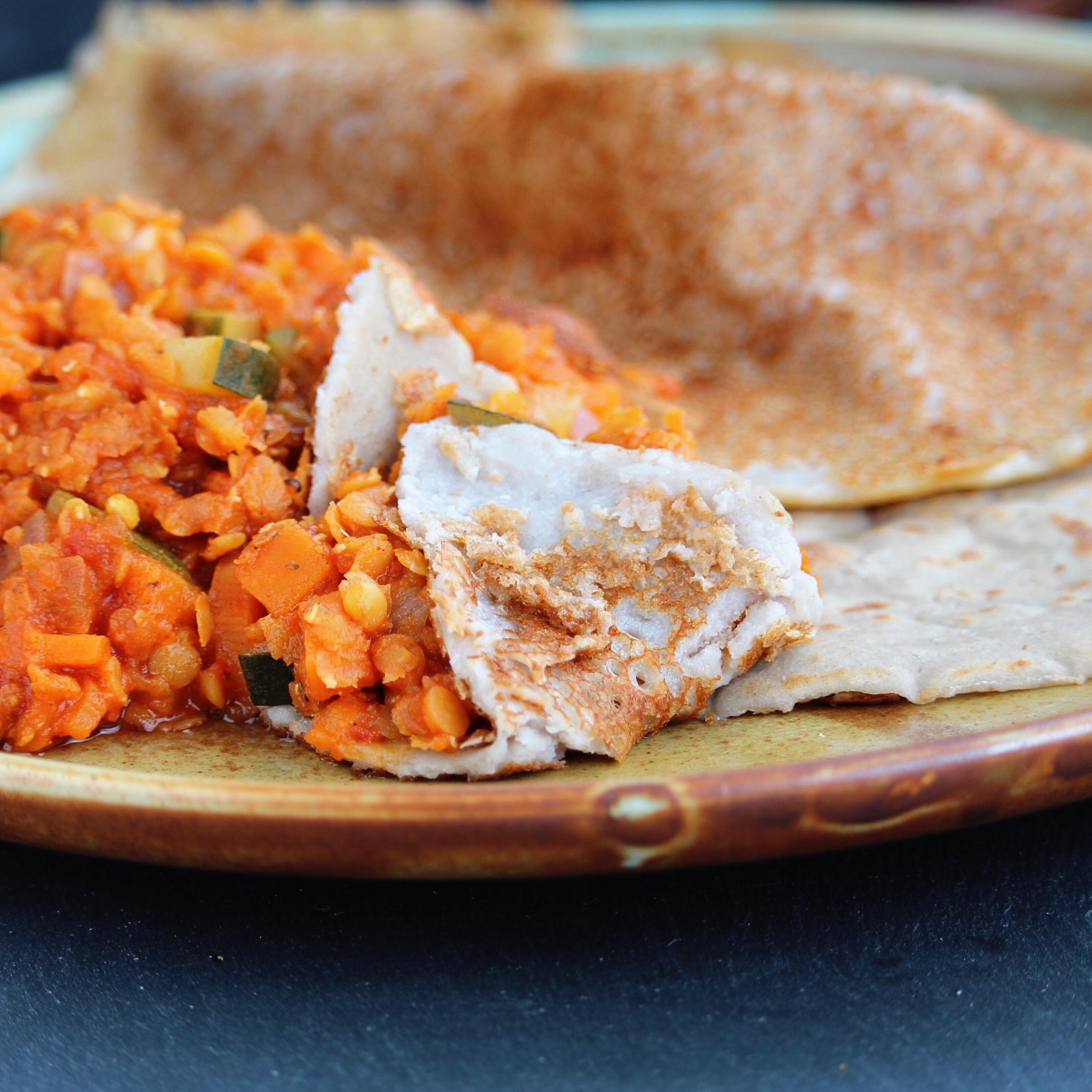
A naturally fermented, spongy, gluten-free flatbread from Ethiopia is made from teff flour and water, using wild yeast to ferment over a couple of days. It is then cooked like a crepe and turned into a flavorful, tangy bread to serve with your favorite Ethiopian food. The fermentation process can take up to 2 or 3 days, depending on your climate. Injera is typically served with vegetables and/or meat on top where the bread is actually an eating utensil.
Provided by Buckwheat Queen
Categories Bread Yeast Bread Recipes Flat Bread Recipes
Time P1DT6m
Yield 2
Number Of Ingredients 6
Steps:
- Mix 1/2 cup white teff flour and brown teff flour together in a bowl. Add 1 cup water and whisk well. Pour mixture into a glass container large enough to hold 3 times the original volume. Cover with cheesecloth or other breathable fabric to keep out dust; do not seal with plastic wrap as air circulation is vital. Leave covered container in a draft-free environment; the mixture needs air to be circulated in order to ferment. Stir batter 2 times over 24 hours.
- Check for bubbles and possibly an increase in volume after 24 hours; there may also be a slightly tangy and sour smell. When you notice these things, add 1 tablespoon white teff flour and 1 tablespoon water to the batter and whisk well. Check in a few hours to see if bubbles have again formed, mixture has increased in volume, and the pungent smell is still evident; if so, the batter is ready and you can skip to the cooking process (step 5).
- Leave batter to rest another 12 hours if the mixture has not begun to form or smell sour after the first 24 hours; stir once during this time. Check to see if bubbles have formed, mixture has increased in volume, and a pungent smell is evident; if so, proceed with step 4.
- Mix together 2 tablespoons white teff flour and 2 tablespoons water in a bowl, making sure there are no lumps. Add mixture to the batter, whisking well. Wait a few hours; batter should be bubbly with a noticeable increase in volume and a pungent but fragrant smell, indicating it is ready to be cooked.
- Heat an 8-inch crepe pan or nonstick skillet over medium heat. Add oil. Pour a scant 1/2 cup batter slowly and steadily into the hot pan in a circular motion from outside to inside. Cover the pan completely in a spiral without swirling. Cover, reduce heat to medium-low, and cook, allowing steam to cook the top of the bread, 1 to 3 minutes. Remove from pan with spatula and transfer to a plate; cover to keep warm. Repeat with remaining batter.
Nutrition Facts : Calories 225.3 calories, Carbohydrate 41.1 g, Fat 3.8 g, Fiber 7.7 g, Protein 6.9 g, SaturatedFat 0.4 g, Sodium 13.9 mg
AUTHENTIC INJERA (AKA ETHIOPIAN FLAT BREAD)

I love eating Ethiopian food, and along with the lovely spicy flavors, injera is a principal reason for that. Try this authentic recipe for injera, which requires planning ahead a few days. The batter, which solely consists of ground teff and water, must ferment prior to cooking. I found the recipe upon which this is based at http://www.angelfire.com/ak/sellassie/food/injera.html, a good source for other information on how to serve the finished product. Preparation time is the fermentation time. As a result of a user query (thanks Jennifer!), this recipe was edited on 9/5/04 to improve teff-to-water ratio and to submit additional instructions.
Provided by Heather U.
Categories Breads
Time P3DT10m
Yield 10 serving(s)
Number Of Ingredients 4
Steps:
- Mix ground teff with the water and let stand in a bowl covered with a dish towel at room temperature until it bubbles and has turned sour; This may take as long as 3 days, although I had success with an overnight fermentation; The fermenting mixture should be the consistency of a very thin pancake batter.
- Stir in the salt, a little at a time, until you can barely detect its taste.
- Lightly oil an 8 or 9 inch skillet (or a larger one if you like); Heat over medium heat.
- Pour in enough batter to cover the bottom of the skillet; About 1/4 cup will make a thin pancake covering the surface of an 8 inch skillet if you spread the batter around immediately by turning and rotating the skillet in the air; This is the classic French method for very thin crepes; Injera is not supposed to be paper thin so you should use a bit more batter than you would for crepes, but less than you would for a flapjack pancakes.
- Cook briefly, until holes form in the injera and the edges lift from the pan; Do not let it brown, and don't flip it over as it is only supposed to be cooked on one side.
- Remove and let cool. Place plastic wrap or foil between successive pieces so they don't stick together.
- To serve, lay one injera on a plate and ladle your chosen dishes on top (e.g., a lovely doro wat or alicha). Serve additional injera on the side. Guests can be instructed to eat their meal without utensils, instead using the injera to scoop up their food.
ETHIOPIAN FLAT BREAD (INJERA)
Not an authentic recipe as it misses out the Teff flour. I made this version as I cannot find Teff anywhere!
Provided by PinkCherryBlossom
Categories Yeast Breads
Time 1h40m
Yield 15-20 serving(s)
Number Of Ingredients 5
Steps:
- Mix everything together to form a batter.
- Let set in large bowl, covered, an hour or longer, until batter rises and becomes stretchy.
- It can sit as long as 3-6 hours.
- When ready, stir batter if liquid has settled on bottom.
- Then whip in blender, 2 cups of batter at a time, thinning it with 1/2 - 3/4 cup water.
- Batter will be quite thin.
- Cook in non-stick frypan WITHOUT OIL (is that a great instruction or what?) over medium or medium-high heat.
- Use 1/2 cup batter per injera for a 12-inch pan or 1/3 cup batter for a 10-inch pan.
- Pour batter in heated pan and quickly swirl pan to spread batter as thin as possible.
- Batter should be no thicker than 1/8-inch.
- Do not turn over.
- Injera does not easily stick or burn.
- It is cooked through when bubbles appear all over the top.
- Lay each injera on a clean towel for a minute or two, then stack in covered dish to keep warm.
- Finished injera will be thicker than a crepe, but thinner than a pancake.
INJERA
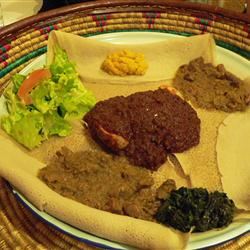
This is the staple bread of Ethiopia. It is traditionally made with teff, a very finely milled millet flour. Regular millet flour from a health food store will work fine. Use this bread to sop up the flavors of spicy stews.
Provided by Anonymous
Categories Bread Yeast Bread Recipes
Time P1DT20m
Yield 14
Number Of Ingredients 5
Steps:
- Dissolve yeast and honey in 1/4 cup of the water. Allow to proof and add the remainder of the water and the millet flour. Stir until smooth and then cover. Allow to stand at room temperature for 24 hours.
- Stir the batter well and mix in the baking soda.
- Heat a large non-stick skillet over medium heat. Pour about 1/3 cup of the batter into the pan in a spiral pattern to cover the bottom of the pan evenly. Tilt the pan to quickly even out the batter. Cover the pan and allow to cook for about 1 minute. The bread should not brown but rather rise slightly and very easy to remove. It is cooked only on one side. This top should be slightly moist. Remove to a platter and cool. Stack the cooked breads on a plate.
Nutrition Facts : Calories 166.1 calories, Carbohydrate 32 g, Fat 1.8 g, Fiber 3.8 g, Protein 5.1 g, SaturatedFat 0.3 g, Sodium 27.6 mg, Sugar 1 g
INJERA (AFRICAN [ ETHIOPIAN] FLAT BREAD)
![Injera (African [ Ethiopian] Flat Bread) image](https://www.tfrecipes.com/img/not-available.jpg)
This is a simplified version of Injera. There are many sites where you can find the more traditional way of making it but this is quite close in taste and texture and 300 times easier. Injera is used the same way some cultures use Tortillas, as a scoop and/or wrap for food. Try this with any sort of saucy dish... it's great and oh so simple.
Provided by JanetB-KY
Categories Breads
Time 17m
Yield 1 batch, 6 serving(s)
Number Of Ingredients 2
Steps:
- Mix the flour with the water; you want to have a somewhat liquid consistency.
- Heat a large non-stick frying pan. The secret of making injera is that the pan be very hot.
- Pour a thin layer (think crepe thinness) of mixture on the pan; cook until the bottom is light brown and the top becomes sponge like.
- You CAN turn it and cook the other side to crispness and brownness but traditionally the top side is supposed to be spongy -- let the bottom cook but don't turn it.
INJERA (ETHIOPIAN FLAT BREAD)

This recipe comes from Classic International Recipes. This dish is popular in Ethiopia, and is used to scoop up stews, or "wat". The recipe information states that it is similar in taste to buttermilk pancakes, but thin, like crepes. Traditionally, injera is formed into a large circle. I posted this to serve with my Recipe #455567 Doro Wat.
Provided by breezermom
Categories Breads
Time 45m
Yield 24 Injera
Number Of Ingredients 9
Steps:
- Stir together the whole wheat flour, all-purpose flour, brown sugar, salt, baking powder and baking soda.
- Combine the eggs, buttermilk, and the 1 tbsp cooking oil; add all at once to the flour mixture, stirring until smooth.
- Pour 2 tbsp of the batter into a hot, lightly greased 6 inch heavy skillet over medium heat; lift and quickly rotate the pan so that the batter covers the bottom of the skillet. Return the skillet to medium heat. Cook about 1 minute or till light brown on the bottom.
- Invert the bread onto paper toweling. (If necessary, loosen the bread with a small spatula.).
- Repeat with the remaining batter. Roll up jelly-roll style and serve warm.
ETHIOPIAN FLAT BREAD (INJERA)

This is an American adaption for Ethiopian Flat bread from "Extending the Table". I found this easy to make though it took a little time. Well worth it for the fun of an African finger-food meal... and tasty too! For more authentic Injera, add 1/2 c. teff flour and reduce whole wheat flour to 1/4 c. (NOTE: Use multiple frying pans to quicken the cooking task)
Provided by luvinlif2k
Categories Yeast Breads
Time 1h50m
Yield 20 12inch Injera
Number Of Ingredients 5
Steps:
- Mix all ingredients in a large bowl.
- Cover and let set an hour or longer until batter rises and becomes stretchy.
- The batter can sit for as long as 3-6 hours if you need it to.
- When you are ready, stir batter if liquid has settled on the bottom.
- In blender, whip 2 c.
- of batter at a time, thinning it with 1/2-3/4 c.
- water.
- Batter will be quite thin.
- Heat a 10-inch or 12-inch non-stick frying pan over medium to medium-high heat.
- Pour batter into heated pan (1/2 c. if using a 12-inch pan; 1/3 c. if using a 10-inch pan) and quickly swirl pan to spread batter as thin as possible.
- Batter should be no thicker than 1/8 inch.
- Do NOT turn.
- Injera is cooked through when bubbles appear all over the top.
- Lay each Injera on a towel for a minute or two then stack in a covered dish to keep warm.
- (VERY important to rest on towel before stacking!) For those not familiar with Injera, serve it as the"utensil" when serving thick stews.
- Use pieces of injera to scoop or pick up bites of stew-- no double-dipping-- eat your"utensil" each time.
INJERA (ETHIOPIAN FLAT BREAD)

Injera is a pliable, slightly fermented flat bread unique to the highlands of Eritrea and Ethiopia. It is an indispensable accompaniment to w'et, the Ethiopian stew. Made of t'eff, a member of the millet family, injera is light, with a somewhat spongy texture. T'eff is not readily available here, so I have substituted wheat...
Provided by Vicki Butts (lazyme)
Categories Flatbreads
Time 40m
Number Of Ingredients 7
Steps:
- 1. Combine the flours and yeast in a ceramic or glass bowl. Add the warm water and mix into a fairly thin, smooth batter.
- 2. Let the mixture sit for three full days at room temperature. Stir the mixture once a day. It will bubble and rise.
- 3. When you are ready to make the injera, add the baking soda and salt and let the batter sit for 10 to 15 minutes.
- 4. Heat a small, nonstick 9-inch skillet. When a drop of water bounces on the pan's surface, take about 1/3 cup of the batter and pour it in the skillet quickly, all at once. Swirl the pan so that the entire bottom is evenly coated, then return to the heat.
- 5. The injera is cooked on only one side and the bottom should not brown. When the moisture has evaporated and lots of "eyes" appear on the surface, remove the injera. Let each injera cool and then stack them as you go along.
- 6. If the first injera is undercooked, try using less of the mixture, perhaps 1/4 cup, and maybe cook it just a bit longer. Be sure not to overcook it. Injera should be soft and pliable so that it can be rolled or folded, like a crepe.
INJERA BREAD

Ethiopian flatbread made of teff flour.
Provided by CURTONA
Categories Bread Yeast Bread Recipes Flat Bread Recipes
Time P4DT20m
Yield 8
Number Of Ingredients 5
Steps:
- Combine all-purpose and teff flours in a bowl. Add salt and mix well. Gradually add water, stirring slowly with a wooden spoon until incorporated.
- Cover bowl with a clean dish towel and leave to ferment at room temperature, 4 to 5 days. Gently agitate the mixture every morning; mixture will appear bubbly and smell sour as it ferments.
- Cook the injera on the 4th or 5th day. Mix batter until smooth. Lightly oil a large pan over medium heat. Add a scoop of batter in a spiral motion, working from the outside to the inside of the pan. Cover and cook until bubbles appear on the surface and steam rises off the top, about 30 seconds.
- Transfer injera to a platter and repeat with remaining batter, adding oil to the pan as needed.
Nutrition Facts : Calories 226.8 calories, Carbohydrate 45.5 g, Fat 1.7 g, Fiber 4.9 g, Protein 6.9 g, SaturatedFat 0.1 g, Sodium 155.5 mg, Sugar 0.1 g
INJERA

Steps:
- 1. Mix ground teff with the water and let stand in a bowl covered with a dish towel at room temperature until it bubbles and has turned sour; This may take as long as 3 days, although I had success with an overnight fermentation; The fermenting mixture should be the consistency of a very thin pancake batter. 2. Stir in the salt, a little at a time, until you can barely detect its taste. 3. Lightly oil an 8 or 9 inch skillet (or a larger one if you like); Heat over medium heat. 4. Pour in enough batter to cover the bottom of the skillet; About 1/4 cup will make a thin pancake covering the surface of an 8 inch skillet if you spread the batter around immediately by turning and rotating the skillet in the air; This is the classic French method for very thin crepes; Injera is not supposed to be paper thin so you should use a bit more batter than you would for crepes, but less than you would for a flapjack pancakes. 5. Cook briefly, until holes form in the injera and the edges lift from the pan; Do not let it brown, and don't flip it over as it is only supposed to be cooked on one side. 6. Remove and let cool. Place plastic wrap or foil between successive pieces so they don't stick together. 7. To serve, lay one injera on a plate and ladle your chosen dishes on top (e.g., a lovely doro wat or alicha).
Tips:
- Use high-quality teff flour. Freshly ground teff flour will produce the best injera.
- Let the batter ferment. The fermentation process helps to develop the sour flavor of injera and also makes it easier to digest.
- Use a well-seasoned cast iron skillet. A well-seasoned cast iron skillet will help to evenly distribute heat and prevent the injera from sticking.
- Cook the injera over medium heat. Cooking the injera over medium heat will help to prevent it from burning.
- Flip the injera carefully. Injera is delicate, so be careful not to tear it when you flip it.
- Serve injera warm. Injera is best served warm, so it's a good idea to make it just before you're ready to eat it.
Conclusion:
Injera is a delicious and versatile bread that can be enjoyed with a variety of dishes. It's a staple food in many African countries, and it's becoming increasingly popular in other parts of the world. If you're looking for a new and exciting bread to try, injera is a great option. With a little planning and effort, you can easily make injera at home.
Are you curently on diet or you just want to control your food's nutritions, ingredients? We will help you find recipes by cooking method, nutrition, ingredients...
Check it out »
#30-minutes-or-less #time-to-make #course #main-ingredient #cuisine #preparation #5-ingredients-or-less #breads #african #easy #ethiopian #pasta-rice-and-grains
You'll also love






